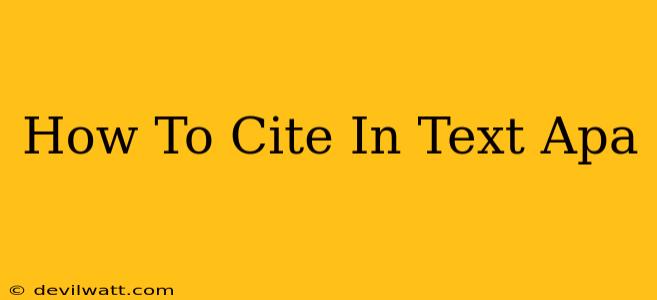Proper in-text citation is crucial for academic integrity and avoiding plagiarism. This guide will walk you through the essentials of APA in-text citation, covering various source types and common scenarios. Mastering this will significantly improve the quality and credibility of your work.
Understanding APA In-Text Citations
The American Psychological Association (APA) style is widely used in social sciences and other fields. Its in-text citation system allows readers to easily locate the corresponding entry in your reference list at the end of your paper. The core principle is to provide enough information for the reader to identify the source without disrupting the flow of your writing.
Key Components of an APA In-Text Citation
A typical APA in-text citation includes the author's last name and the year of publication. This information, enclosed in parentheses, is usually placed at the end of the sentence containing the cited information. For example:
Research suggests a strong correlation between sleep deprivation and reduced cognitive function (Smith, 2023).
Let's break this down:
- Smith: This is the author's last name.
- 2023: This is the year the work was published.
Different Citation Scenarios
The basic structure changes slightly depending on the type of source and how you're incorporating the information.
1. One Author:
As shown above, a single author citation is straightforward: (Author's Last Name, Year).
The effects of climate change are undeniable (Jones, 2022).
2. Two Authors:
When citing works by two authors, include both last names, separated by an ampersand (&):
Recent studies highlight the importance of early intervention (Brown & Davis, 2021).
3. Three or More Authors:
For sources with three or more authors, cite only the first author's last name followed by "et al.":
A meta-analysis confirmed previous findings (Garcia et al., 2020).
4. No Author:
If a source lacks an author, use a shortened version of the title in place of the author's name:
The report emphasized the need for sustainable practices ("Climate Action Plan," 2024). (Note: Italicize the title if it's a book or report; use quotation marks for articles)
5. Direct Quotations:
Direct quotations require page numbers (or paragraph numbers for online sources without page numbers):
"The impact of social media on adolescent mental health is a complex issue" (Miller, 2023, p. 15).
Important Note: Always double-check the accuracy of your page numbers.
6. Multiple Works by the Same Author in the Same Year:
If you cite multiple works by the same author published in the same year, add lowercase letters (a, b, c, etc.) after the year to distinguish them:
(Smith, 2022a) and (Smith, 2022b)
7. Incorporating Citations into Your Sentences:
You can also incorporate the author's name directly into the sentence, followed by the year in parentheses:
Smith (2023) argues that...
Common Mistakes to Avoid
- Incorrect punctuation: Pay close attention to punctuation; using commas incorrectly can lead to errors.
- Missing information: Always ensure you include all necessary elements (author, year, page number for quotations).
- Inconsistent formatting: Maintain consistency throughout your paper.
- Plagiarism: Always properly cite any information that is not your original thought or work.
Mastering APA In-Text Citations: Practice Makes Perfect
The best way to improve your APA in-text citation skills is through practice. Familiarize yourself with the rules, and carefully review examples. If you are still uncertain, consult the official APA Publication Manual or seek guidance from your instructor or librarian. Consistent and accurate citation is essential for producing high-quality academic work.
Keywords: APA in-text citation, APA citation, in-text citation, APA style, academic writing, citation guide, plagiarism, referencing, author-date system, direct quotation, indirect quotation, multiple authors, no author, same author same year, academic integrity.

